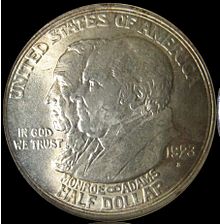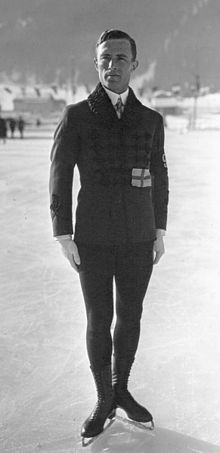Portal:1920s
The 1920s Portal
Silent films were popular in this decade, with the highest-grossing film of this decade being either the American silent epic adventure-drama film Ben-Hur: A Tale of the Christ or the American silent war drama film The Big Parade, depending on the metrics used. Sinclair Lewis was a popular author in the United States in the 1920s, with his books Main Street and Elmer Gantry becoming best-sellers. Best-selling books outside the US included the Czech book The Good Soldier Švejk, which sold 20 million copies. Songs of this decade included "Mack the Knife" and "Tiptoe Through the Tulips". During the 1920s, the world population increased from 1.87 to 2.05 billion, with approximately 700 million births and 525 million deaths in total. (Full article...) Selected article - The Monroe Doctrine Centennial half dollar was a fifty-cent piece struck by the United States Bureau of the Mint. Bearing portraits of former U.S. Presidents James Monroe and John Quincy Adams, the coin was issued in commemoration of the centennial of the Monroe Doctrine and was produced at the San Francisco Mint in 1923. Sculptor Chester Beach is credited with the design, although the reverse closely resembles an earlier work by Raphael Beck. In 1922, the motion picture industry was faced with a number of scandals, including manslaughter charges against star Roscoe "Fatty" Arbuckle. Although Arbuckle was eventually acquitted, motion picture executives sought ways of getting good publicity for Hollywood. One means was an exposition, to be held in Los Angeles in mid-1923. To induce Congress to issue a commemorative coin as a fundraiser for the fair, organizers associated the exposition with the 100th anniversary of the Monroe Doctrine, and legislation for a commemorative half dollar for the centennial was passed. (Full article...)Featured picture Sultan al-Atrash was a prominent Arab Druze leader, Syrian nationalist and Commander General of the Syrian Revolution (1925–1927). He fought against the Ottomans, French, and even against the Syrian government in days of dictatorship. One of the most influential figures in Syrian and Druze history, he played a major role in deciding the destiny of Jabal ad-Duruz and of Syria in general. Did you know...
Related portalsSelected biography -
Gillis Emanuel Grafström (7 June 1893 – 14 April 1938) was a Swedish figure skater. He was born in Stockholm, Sweden. He won three successive Olympic gold medals in Men's Figure Skating (1920, 1924, 1928) as well as an Olympic silver medal in the same event in 1932, and three World Championships (1922, 1924, 1929). He and Eddie Eagan are the only athletes to have won a gold medal at both the Summer and Winter Olympic Games. Grafström has the further distinction of being the only person to have won an individual gold medal in both the Summer (1920) and Winter Olympics (1924, 1928), although Eagan remains the only one to have managed the feat in different disciplines. Grafström is one of the few athletes who have competed in both the Summer and Winter Olympic games. He is one of the oldest figure skating Olympic champions. (Full article...)
TopicsWikiProjects
List articlesMore Did you know (auto generated)
CategoriesGeneral imagesThe following are images from various 1920s-related articles on Wikipedia.
Recognized content
Associated WikimediaThe following Wikimedia Foundation sister projects provide more on this subject:
Discover Wikipedia using portals |




















































